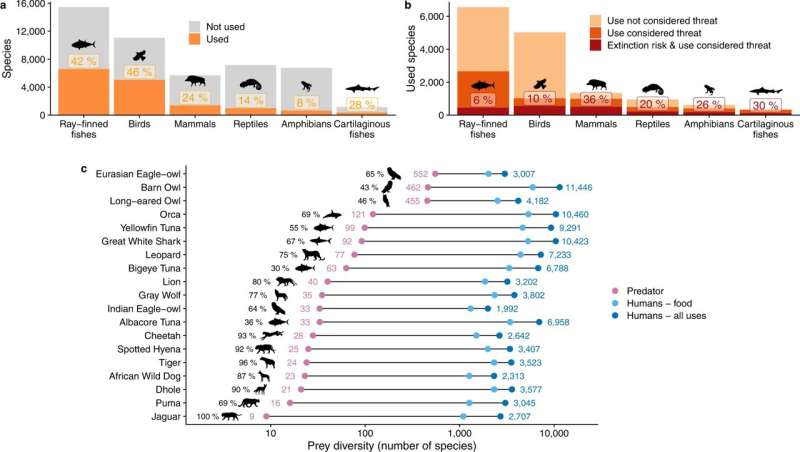June 30, 2023 report
This article has been reviewed according to Science X's editorial process and policies. Editors have highlighted the following attributes while ensuring the content's credibility:
fact-checked
peer-reviewed publication
trusted source
proofread
Humans found to prey on approximately one-third of all vertebrate species

An international team of ecologists, life scientists, conservationists and biologists has found that humans prey on approximately one-third of all vertebrate species in existence. In their study, reported in the journal Communications Biology, the group analyzed data collected by members of the International Union for Conservation of Nature (IUCN).
Prior research has shown that humans are the ultimate apex predator. Our species not only catches and eats prey, but domesticates certain animals to collect their milk, to make leather from their hides or to keep them as pets. In this new effort, the research team wondered just how many vertebrate species humans prey on—in their study, they defined predatory behavior as acts that remove animals from their natural environment, either dead or alive, and use them for a source of food or as a harvesting or trade resource.
To find their answer, they turned to the IUCN, an organization made up of both civil and governmental organizations engaged in monitoring, protecting, and conserving natural resources. Its 1,400 members have become a well-known resource for natural resource status reports. In this effort, the researchers focused only on the 47,665 vertebrate species tracked by the organization.
In looking at the data, the researchers found that humans prey on approximately 14,663 species, which is approximately a third of those known to the IUCN. They also found that nearly 40% of the species preyed upon by humans are listed as threatened. More specifically, they found that approximately 55% of these species are eaten. And they found that more than half of all the terrestrial species preyed on by humans are part of the pet trade. Also, humans hunt approximately 358 species of finned fish for sport and 452 species of birds—and 207 species of mammals and fish are used for clothing. They also found that 192 mammal species and 82 amphibian species are used for medical purposes.
The research team notes that such large numbers make humans far and away the biggest predator on the planet—summing it up, they found that humans prey on other species at a rate 300 times that of any other predator when accounting for the size of predation areas.
More information: Chris T. Darimont et al, Humanity's diverse predatory niche and its ecological consequences, Communications Biology (2023). DOI: 10.1038/s42003-023-04940-w
Journal information: Communications Biology
© 2023 Science X Network


















